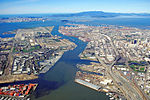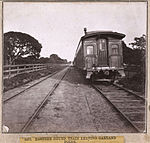Oakland Long Wharf

The Oakland Long Wharf was an 11,000-foot railroad wharf and ferry pier along the east shore of San Francisco Bay located at the foot of Seventh Street in West Oakland. The Oakland Long Wharf was built, beginning 1868, by the Central Pacific Railroad on what was previously Oakland Point. Beginning November 8, 1869, it served as the west coast terminus of the First Transcontinental Railroad. In the 1880s, Southern Pacific Railroad took over the CPRR, extending it and creating a new ferry terminal building with the official station name Oakland Pier. The entire structure became commonly and popularly called the Oakland Mole. Portions of the Wharf lasted until the 1960s. The site is now part of the facilities of the Port of Oakland, while passenger service runs to the nearby Jack London Square/Dellums Station
Excerpt from the Wikipedia article Oakland Long Wharf (License: CC BY-SA 3.0, Authors, Images).Oakland Long Wharf
7th Street, Oakland
Geographical coordinates (GPS) Address Nearby Places Show on map
Geographical coordinates (GPS)
| Latitude | Longitude |
|---|---|
| N 37.81 ° | E -122.326 ° |
Address
7th Street
7th Street
94130 Oakland
California, United States
Open on Google Maps








